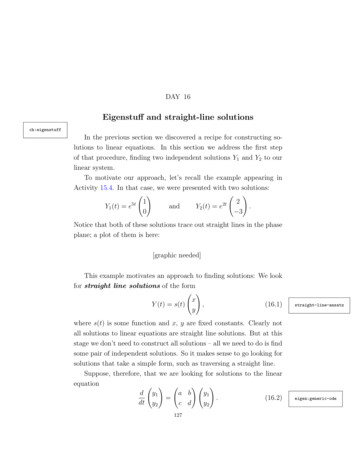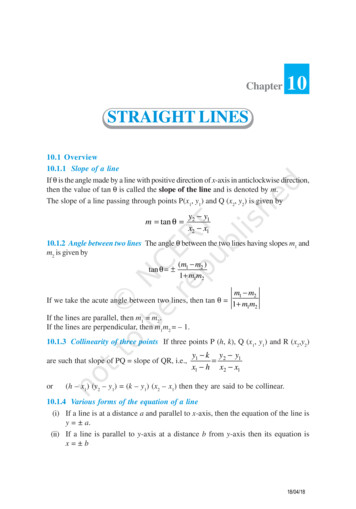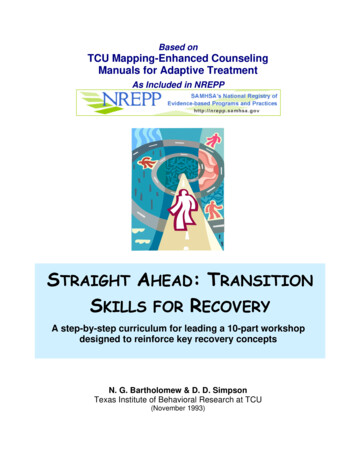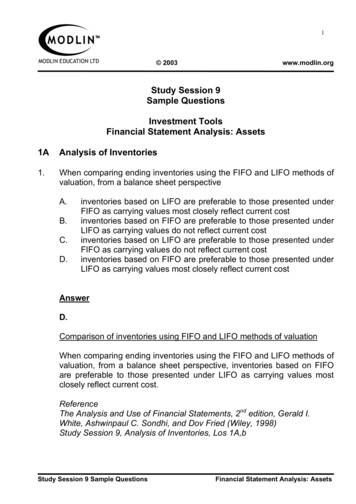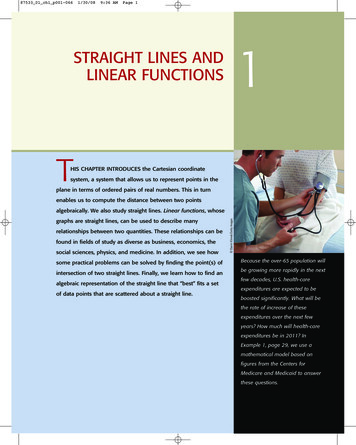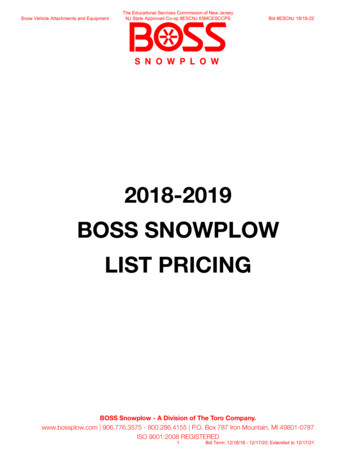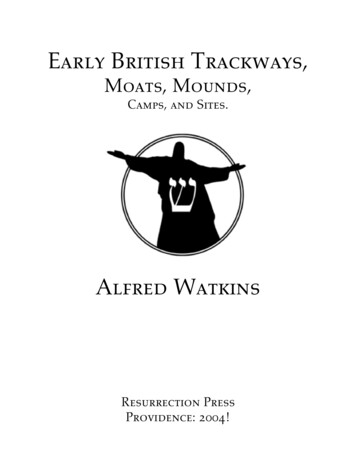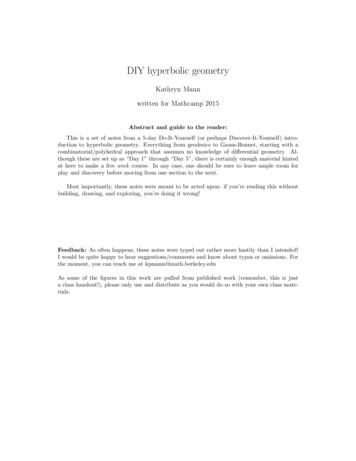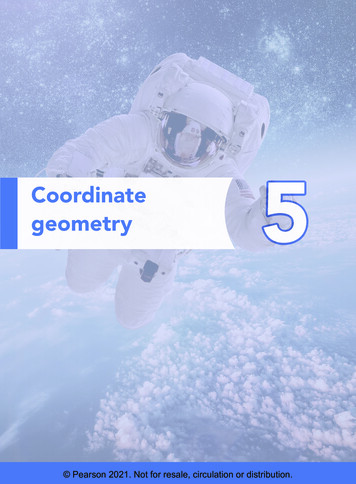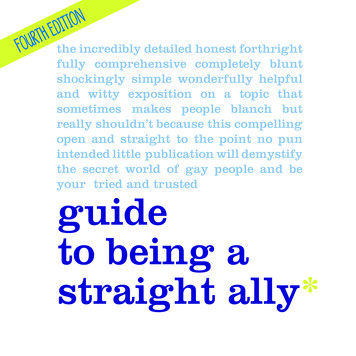
Transcription
htrufoNOITEDIthe incredibly detailed honest forthrightfully comprehensive completely bluntshockingly simple wonderfully helpfuland witty exposition on a topic thatsometimes makes people blanch butreally shouldn’t because this compellingopen and straight to the point no punintended little publication will demystifythe secret world of gay people and beyour tried and trustedguideto being astraight ally*
welcome to the fourth edition!What a difference four revisions can make.When the first edition of the guide to being a straight ally was released in 2007, the number ofpeople who said that they knew someone who was lesbian, gay, or bisexual was a mere 4 in 10.In the workplace, many organizations were just starting to have conversations about the roleof allies to the lesbian, gay, bisexual, transgender, and queer (LGBTQ ) community. And thethought of marriage equality was still aspirational.Twelve years later, the world is a different place. Now, 8 in 10 people say they know someonewho is lesbian, gay, or bisexual—and connections to people who are trans are constantlygrowing, with current estimates at around 37% of the U.S. population saying they personallyknow someone who is trans-identified. The engagement of allies at work has become the rulefor organizations, not the exception. And in the United States, marriage equality is the law ofthe land. Notably, the win was marked by the support of allies who raised their voices alongsidetheir gay and lesbian friends and family.For PFLAG National’s Straight for Equality program, the response from allies (and theLGBTQ people who love them) has been overwhelming. As of this writing, more than 150,000copies of this book in its first two editions have been distributed in print, with thousands moredownloaded. The series now includes three other books, including the guide to being a transally, which pushes those numbers above 200,000 copies. Over 17,000 people have participatedin Straight for Equality learning sessions (of which there are now 16). And PFLAG chapters areengaging allies in their communities from coast to coast.The fourth edition reflects much of the progress that has been made, and the evolving barriersthat remain on the path to active allyship. We’ve learned a lot along the way from the allies whohave welcomed us into their lives, and it is our great hope that the new content honors whatthey’ve shared and helps to engage more allies.We continue to say that achieving equality and full inclusion will never be done alone. So, asalways, we’re thrilled that you’re here.
I remember being in school and learning about thecivil rights and other social movements for equalityand thinking to myself, ‘Well, if I had been old enoughthen, I would have stood up and done the right thing.’And now I am. In spite of great progress like gayand lesbian people being able to marry, I still seeinequality, and I know that I should do something. Butit just isn’t that easy. I have so many questions. I don’tknow everything. I’ve got some fears. And I’m just notsure where—if anywhere—I belong in the LGBTQ equality movement.Katie, 29
Sound familiar? Feeling the same way?You’ve come to the right place.Welcome to Straight for Equality.While some incredible progress has been made towards equality and fairness for peoplewho are LGBTQ , we’re not there yet. Full equality can’t happen without support from smart,energetic, compassionate, and dedicated allies. Basically, people just like you. (See? We just metand already have complete confidence in your abilities.)Straight for Equality is a program developed by PFLAG National specifically created for peoplewho want to stand up for LGBTQ equality but may not be sure how or even where they fit in.Straight for Equality invites, educates, and engages people who are not LGBTQ in supportingand advocating for LGBTQ equality in their homes, workplaces, and all of the communitieswhere they live and belong.Straight for Equality isn’t about politics or politicians, Republicansor Democrats, radical activists or peacekeeping pacifists. Whilethat may seem a little impossible, stick with us for a bit and seewhat it’s about.This project is about creating a place where all people who care about fairness can honestlyand openly discuss and remove the barriers they face to becoming allies, get specificrecommendations for action, and learn how to assist others—whether friends, family members,coworkers, or community members—in becoming agents of change.For people who identify as LGBTQ , the project provides a different way to think aboutconnecting with allies, and offers resources that you can share to help them learn whatallyship means. It also provides guidance on how you can support their ally journey. This book3
specifically addresses issues related to sexual orientation, while the guide to being a trans allyfocuses on gender identity and expression. Allyship can take different paths, so look for waysthat you can support allies as well as how you might become a stronger ally to other peoplewithin the LGBTQ community.Got questions?We’ve got some answers. Through publications like this one, our website, social media,in-person learning sessions, or with suggested resources, we can help you find what you need.Got concerns?That’s natural—and healthy! We’ll do what we can to resolve your concerns and introduce youto people who had similar experiences and are willing to share their ally stories. Being an allyis not without its challenges. There are lots of issues and barriers that may keep people fromgetting involved, and that’s why we’re here. This book is just the first step.Don’t know how to get involved?Keep reading. We’re getting there. Pinky promise. Look for the invitations to action throughoutthis book for a few great ideas.Already see yourself as an ally?There’s plenty of stuff inside for you, too. Look for ways to become more active and ideas forhow you can engage and support new people on their ally journeys.Allies (and potential allies), your time has come.4
Equality guidepostsThis book features a few nifty little icons to help you during your ally journey.Here’s what they mean:Stumbling BlocksCaution with a twist. Read real-life stories from people about how theystruggled to understand a situation, confronted a fear, or tried somethingnew. These narratives are good reminders that you’re not alone in your allycoming out process or in becoming a more active straight ally.Phone-a-FriendGet quick access to great resources that can help you get past yourstumbling blocks and on the road, straight to equality. (Bad pun fullyintended.)Your InvitationLearning more about how to be a powerful ally opens up a whole new setof opportunities for you to change your world. Take advantage of theseinvitations to try something new and help move equality forward.Equality LiteracyWhile you’re reading this book, it’s possible that you’ll find some words with which you’re notfamiliar. Don’t panic. Check out the equality literacy glossary starting on page 43 for help.5
allynoun al . ly6
Who are allies, anyway?We’ve already mentioned them more than a dozen times, and the word seems simple tounderstand, right? Maybe. But chances are that if you ask a group of 10 people what “ally”means, you’ll get 10 different answers. That’s actually a good thing.So before we get into what allies can do to create meaningful change for their LGBTQ friends, classmates, and colleagues, let’s talk about what the word really entails.In the beginning, there were lists.As PFLAG National developed the Straight for Equality project in the time leading up toits 2007 launch, we started by researching how the word “ally” was being used within theLGBTQ equality movement. Certainly allies have always been here and doing importantwork, but we needed to explain who an ally is and the expectations around creating change.After all, what is the chance that someone would say they’d like to be an ally if they don’tknow what it is, or what’s expected of them?We went to work. We searched high and low for definitions of what allies are within theLGBTQ movement and what we found were lists.There was the list of five things you must believe to be a good ally. The list of 25 things youmust be doing to be a good ally. Even the list of 150 things that you need to believe and dobefore you earn the right to call yourself an ally. Even the explanations that were not listbased had some big requirements for people who wanted to adopt the term. Allies had tochallenge homophobia and transphobia every single time they encountered it. Allies had tovote in a very specific way. Allies need to acknowledge and work to subvert their heterosexualprivilege. Allies had to give money to LGBTQ organizations. Allies needed to only belong tofaith communities that are openly supportive of people who are LGBTQ .7
These are some legitimately worthy goals, and are good options for some allies. But in the end, thesame question kept coming up: aren’t people worth so much more than being reduced to a list ora set of rigid demands—some of which would probably exclude many people from the effort?We think so.We went back to the drawing board and thought about what the path to being an ally reallylooks like. We thought how we might be able to expand it to bring more people on the journey.And leveraging the more than 45 years of experience that PFLAG has in helping people becomeaccepting—and sometimes even advocates—we found ourselves looking at things differently.Our first step was to do a definition purge, and the second entailed drawing a picture.Rather than developing a stiff set of requirements for someone to be an ally, we thought aboutthe qualities people—regardless of where they are on their ally journey—possess: Allies want to learn. Allies are people who recognize they don’t know all thatcan be known on LGBTQ issues or about all the experiences of people who areLGBTQ , but they want to understand more. Allies address their barriers. They may have to grapple with some roadblocks tobeing openly and actively supportive of people who are LGBTQ , and they’rewilling to take on the challenge. Allies are people who know that support comes in many forms. It can meansomething super-public (think covering yourself in rainbow glitter and headingto a Pride celebration with a sign reading, “PROUD ALLY”*). But it can alsomean expressing support in more personal ways through the language we use,conversations we choose to have, and signals that we send. True allies know thatall aspects of allyship are important, effective, and should be valued equally. Allies are diverse. Allies are people who know that there’s no one way to be anally, and that everyone gets to adopt the term in a different way and that’s ok.An admirable move. Great for Pride. But chances are it isn’t practical for everyday kinds of stuff.*8
As we started to think about the qualities of allies, the terms “journey” and “spectrum” keptcoming up. The process of going from “not my issue” to “someone take me to my legislator to fixsome laws!” rarely happens overnight. It usually entails a process of learning more, becomingcomfortable enough to talk about the issue openly, knowing how to take on pushback, andeventually being able to help others in their ally journeys.And that ally journey, as we looked at it, felt like its own coming out process of sorts. So wegrabbed our sketchpads and went to work.Behold, the Straight for Equality Ally Spectrum :9
Why is the ally spectrum useful?First, it acknowledges that allies can be found across the spectrum of support, from the peoplewho say, “Not my issue but I’ll listen to you,” to those who feel comfortable finally saying“LGBTQ ” and talking about issues out loud, to those who get the LGB part, but want tounderstand the T, right through our super allies, who are off and trying to make lasting change.Second, it is a reminder that no matter where people are on the spectrum, they are allies. Noneed to become an advanced ally before you claim the title. There are things to learn andthings to do at every single point.Finally, it gets rid of that icky feeling that we all get when we’re forced to ignore all of thecharacteristics, backgrounds, and experiences that make people who they are and try tosqueeze them into a box to fit our own ideas about who they ought to be. Shake free the chainsof being just a list or one definition, people! Now is your time to embrace your ally diversity.(Interested in more about the Ally Spectrum and things to do at different points on thejourney? Keep reading, but also visit us online at straightforequality.org/allyspectrum.)So why is this term so important? Why the “label”?Even super-brainy people have taken on this issue. Philosopher Søren Kierkegaard (ally statusunknown) once wrote that, “Once you label me, you negate me,” suggesting that labeling anyindividual compromises their individuality.We actually agree. Labels really aren’t for people at all.But to us, identifying as an ally isn’t a label—it is a term of empowerment. It is a state of being,an explanation of who someone is, and where their values lie. It communicates key things thatmatter to them—LGBTQ equality, care for their LGBTQ friends, family, and colleagues—in apowerful way. It is a vocal and positive stand that clarifies an important point: While I may notbe LGBTQ , LGBTQ issues are my issues, too.“You’re messing with my head!” you say. “Straight allies and allies with no specifics why?”10
There’s a lot of conversation about it, and it tends to sound something like this: if the point isthat your sexual orientation or gender identity/expression shouldn’t matter, then why makesuch a point of mentioning it when we talk about being allies?The short answer? Because it does matter.Don’t get us wrong—the goal is that one day none of this will be relevant. (At PFLAG, we jokethat our job is to do such a good job at achieving equality and inclusion that we’ll be able toput ourselves out of business.) But for now, it is relevant.Consider this: As of this writing, roughly half of people who are LGBTQ are not out in theirworkplaces. About 50% of LGBTQ Americans say that they’ve experienced discriminationin their personal lives, in places like the workplace, housing, and education. Among LGBTQ youth in schools, nearly 60% say that they feel unsafe in their schools simply because of theirsexual orientation, while almost 45% say they feel unsafe because of their gender expression.In order to change these jarring statistics, we need to have a spectrum of diverse voicesexpressing their support for equality and inclusion—and that includes people who are notmembers of the LGBTQ community. They have a unique power to send the message thatinclusion and equality aren’t just things that people in the group affected want (in other words,LGBTQs), but something that everyone wants. And in order to make that unique, “It’s not aboutme, but it really is about me” statement, talking about our background as someone who isn’tLGBTQ , but owns this issue is often necessary.Where do we go from here?By now, you’ve hopefully started taking a bit of an ally journey of your own. Maybe you’rerethinking how you personally understand the term “ally.” There’s a chance that you consideredwhere you might be on your ally spectrum right now and what it will take to move forward.Maybe you’ve even started thinking about what some of your barriers might be to becomingan out and proud straight ally.If you’ve thought about these things—or thinking about them now—we’re on the right track.11
SIDENOTEEver wonder if your support as an ally matters to people who are LGBTQ ? We can tellyou it does, but some of these narratives from LGBTQ people really help illustrate thetremendous power that your contributions have, even if you don’t see them.“My office had a Pride event last June, and the focus was on straight allies. Seeing so manypeople stepping up and saying that they are allies made me feel more secure and inspired me tocome out. The best part? My boss was one of those proud straight allies! I never really thought I’dbe out at work, but that was the signal that it could happen.” —Roberto“One of my favorite teachers at school has a safe space sticker at their desk and really tries to useinclusive language all the time. They even talked about gender-neutral pronouns in one class.Seeing the sticker and hearing those words made me comfortable talking about gender identityand even asking some questions of the teacher that I’ve never asked anyone before. I’m not surehow I identify quite yet, but having someone so open about how they’re trying to understandwhat I’m going through really mattered to me.” —Satabdi“I’m very, very out. But even as a person who is incredibly open about talking about her sexualorientation, I still sometimes worry how someone might react when I come out to them.Recently, I was on a trip when the person next to me on a flight struck up a conversation. Whenhe turned around to ask me about my background, he noticed my wedding ring, paused ina question that was going to be about what my husband does, and then asked me what mypartner does. He said that he tries to assume nothing. That one word change made all of thedifference for me. I knew I could be open, and the conversation was going to be comfortable. Ireally appreciated that.” —Jane“The support of allies has been crucial to my family. Just last week, my son was repeatedlyteased about being a girl because of how he looks, and how other kids perceive him. He hatesthat. But this time, several girls in his class stood up for him and his right to wear what he wants.They know that boys can like pink. I think that these kids—these allies—are vital to making myson feel safe at school.” —Marissa12
13
I was telling a friend of mine about how my sister isgetting married. She was excited and asked, ‘Herfiancé what does he do?’I didn’t want to make her feel put on the spot, so Ismiled and said, ‘Not he —she’s marrying a chick!’We’ve been friends for years, and I knew that makingher laugh a little would be the right approach. I sawthe look on her face as she processed what I said andrealized that she’d just assumed my sister is straight.She laughed and said, ‘So what does this chick do?’Because I spoke up, she knew about my family, noone was uncomfortable, and I felt good about beinghonest and choosing to have the conversation withher. But it took me a while to get to the point of doingit. Being open took work to overcome some of my fears.Stephanie, 3414
About those barriers.As Bob Dylan wrote, the times, they are a-changin’. Just a look around our everyday lives and youcan see more visibility, and, in many ways, acceptance, for people who are LGBTQ . Count thenumber of shows that you watch that have LGBTQ characters or storylines. Watch the news andpeople are talking about the fact that people who are gay, lesbian, and bisexual now have theright to marry their same-sex partners. In schools, gay-straight alliances (or GSAs) are common,while workplaces feature employee groups for people who are LGBTQ and their allies.So it should be easier than ever to be an ally, right?Not always. In fact, sometimes the progress going on around us makes the stakes feel evenhigher for straight allies to speak up and become active. Progress around us doesn’t alwaystranslate into feeling the confidence to initiate new conversations, deal with conflict, or evenbe an out ally. And sometimes even progress can feel like it makes people’s deeply-held ideasbecome even stronger as they feel that their way of seeing things as being challenged. Thissense of challenge often seems to make a big disagreement seem more likely, and the prospectof even starting a conversation tougher.But remember where we talked about who allies are just a little while ago? (Like in that lastchapter?) One of those big characteristics of allies is to identify barriers to being an ally andwork through them. So let’s talk a little bit about some of the most common barriers that alliesoften run into, shall we?15
“You know not that there’s anything wrong with that”“I sometimes feel a little like a cliché these days. I’m one of those people who willtell you that I’ve got several gay friends, and even recently became friends with aman who is trans. And I take my responsibility to be an active ally who speaks upseriously. This sounds silly, but sometimes I get worried that when I do, people willthink that I’m gay, too you know, like that Seinfeld episode said, not that there’sanything wrong with that. I’m single, and I can see them jump to conclusions, andit isn’t comfortable for me because I’m an ally. But I don’t know how to address it,and it gets awkward, and I find that sometimes I end up not speaking at all.”— Mark, 42There’s a reason that more than 20 years after a Seinfeld episode in which the line, “I’m notgay not that there’s anything wrong with that” was used it, is still relevant (and funny). Thetruth is that straight allies are rarely given instruction on how they “come out” as allies.For some people, recognizing some of the negative treatment that people who are LGBTQ receive will make them nervous about speaking up. Discrimination is still real at work, in ourcommunities and all around us. The need to minimize this fear by being able to self-identify assomeone who is not LGBTQ may help them navigate this fear and be more outspoken.For others, there’s a realization that their status as a person who is not LGBTQ is importantbecause it sends a unique message about LGBTQ equality from someone who is not directlyaffected by progress made. The thought of not using that status as part of your super-changemaking abilities can feel defeating. But still, people often don’t know how to state their allystatus effectively.And then, there are some that may be concerned about how speaking up may impact theirdating prospects. (Just joking. Or not. Maybe sometimes?)This isn’t a thing that is insurmountable—nor is it a barrier that makes someone a bad ally.Finding a comfort zone from which you can express your allyship is critical to being able totravel your ally journey. There’s no shame here.16
Dear ally, meet PFLAG.Straight for Equality is a program of PFLAG National. PFLAG, our “parent”organization (in more than one way) was founded in 1973 by Jeanne Manford inNew York City. She and other parents—at a time when publicly supportive familiesof people who are gay and lesbian were rare—started a group which has come tobe known as the country’s original family and ally organization.Comprised of family members, friends, allies, and people who are LGBTQ , PFLAGhas a three-part mission of support, education, and advocacy that is carried outby its more than 350 chapters across the United States, in a network of more than200,000 members and supporters.PFLAG chapters continue to support families through the coming out processthrough peer support groups, but their work is much bigger than that. They offerunique community-based opportunities for allies to become more educatedabout equality-focused issues as well as ways to get engaged where they live.They’re a great way to get support in your ally journey as well as connect withother allies. Learn about PFLAG and find your local chapter by visiting pflag.org.17
“I didn’t want to make her—or me—feel uncomfortable or startan argument ”“I was talking to a friend who lives in the same assisted living center that I do. Shewas telling me about attending her granddaughter’s wedding, and asked howmy grandson is doing. I said he’s well, but because I didn’t want to offend her,I neglected to mention that he and his partner of 10 years just had a beautifulwedding, which I proudly attended. I love my grandson and his husband, butsometimes I just don’t want to risk making other people uncomfortable bymentioning that he is gay. Worse, the thought of having to argue about it withsomeone just makes me back away.”— Evelyn, 74Of all the challenges that straight allies talk about, the fear of getting into an argumentor making people uncomfortable always tops the list. We’re a culture where the idea ofeveryone being able to have their own opinion prevails, but when those opinions clash, well,awkwardness (or worse) ensues.Am I going to lose a friend? Am I going to create a bad relationship with a neighbor? Might Ihurt my personal brand at work because someone disagrees strongly? Will what I say lead tosome really awkward and uncomfortable silence? Will I end up getting excluded?These are just a few of the questions asked by straight allies in moments of possible conflict.They also happen to be the same kinds of questions that many people who are LGBTQ areasking when they hit conflict, too. We tend to be the same like that.It would be easy to say that you’ve just got to be brave and speak up, but that also would besilly and unreasonable. There are consequences to our actions, and understanding them needsto be a real calculation. But there are consequences to inaction, too. Big ones.For allies (no matter where they are on their ally journey) understanding that there’s no oneway to respond when potential conflict arises is important. It isn’t always about grabbing yoursoapbox and yelling. And that alone may make this fear seem just a bit more manageable.18
SIDENOTEIf there’s one thing that makes people panic, it’s the thought of getting into an argument.Add the fear of consequences of arguments, and it creates a special recipe for shutting down.But conflict isn’t always a bad thing. Often, it is the beginning of an important conversation,but only if you take on the discussion in a constructive way. Changing the way you approachdisagreement can transform a moment of ally panic into a moment of ally win. Here are a fewsteps to try out when you feel yourself backing down, or not speaking up.Take a deep breath: If you’re extremely upset, the way that you approach the conversation willreflect it. Step back and let your temperature come down. Retract those claws.Assume nothing: You don’t always know what drives someone’s opinion. Sure, it may be reallygross bias. But it also might be because they didn’t think or know what they said or did washurtful, or because they thought people would see it as a joke. Give people room to explain.Pick the right time and place: While there may be a momentary rush of self-satisfaction inmaking a scene as you point your finger, don’t. Instead, approach the person and ask if you canhave a quick private conversation.Address the behavior: Be sure to explain what you’re referring to—and then keep theconversation about that specific behavior. In other words, “I felt like the joke you made aboutgay people was really messed up,” works because it makes the topic of conversation the joke.Whereas, “I am here to tell you that I think that you’re a great big homophobic jerk” doesn’taddress the behavior, but attacks the person’s character.Explain why you’re speaking up: Let people know why you felt that something is wrong andthe impact that it had. Try something like this: “As someone who is a straight ally, I’m makingan effort to talk to people when they say something that doesn’t seem right. And I feel like thejoke you made is insulting to people who are gay.”Listen and offer support: Listen to the other person to hear what they’ve got to say. Maybethey’ll apologize or tell you they didn’t think it would hurt anyone. Maybe they’ll say somethingthat helps you see where they’re coming from. You won’t know unless you’re really listening. Letthem know that you’re a resource if they ever want to talk.Say thank you: This is important. You’ve just done something big, and engaged someone elsein the process. No matter how it goes, thank people for their time.19
“What exactly am I supposed to do now?”“I’m an ally. Well, maybe I’d call myself an ally in training. I want to do the rightthing, and I know that the next part of my work is finding ways to be outthere about my beliefs. But it leaves me wondering how I’m supposed to getconversations going. I mean, ‘I have a gay friend’ just sounds weird and not useful.But when I talk politics, people tend to back off. I’m at a loss here.”— Arthur, 23Right now, more people than ever know someone who is LGBTQ , and with each day, it seemslike more are identifying as allies. And while this momentum can be super-empowering, itdoesn’t really provide much guidance for being allies outside of more “political” conversations.Let’s face it. It can be pretty easy for straight allies to demonstrate their support at a Pridefestival or even a political rally.But in the absence of one of these opportunities, finding ways to still be out about your allyshipisn’t always simple. How do allies keep the conversation about equality going—or, even moreimportantly, find ways to integrate it into everyday life? How can allies become people who caninitiate conversations about equality in a wide variety of ways you know, beyond, “I’ve got alesbian friend”?In the upcoming pages, you’ll find some basic, everyday changes you can make that will helpyou do it, so stay tuned.20
Put your assumptions in check.We’re constantly making assumptions about people. Seriously, all of us doit. Because of where someone is from, the kind of work they do, their familybackground, their religious beliefs (or lack thereof ), their appearance, the waythey speak—and much more—we make snap judgements about what kinds ofpeople they are and where their values lie.But that’s just what we’re doing: making snap judgements. And they’re basedon the little info that we have, and, importantly, our own biases, conscious orunconscious.So here’s your first invitation to action as an ally: Put your assumptions in checkabout who is (and is not) supportive of LGBTQ equality, or even about theirwillingne
For PFLAG National’s Straight for Equality program, the response from allies (and the LGBTQ people who love them) has been overwhelming. As of this writing, more than 150,000 copies of this book in its first two editions have b
